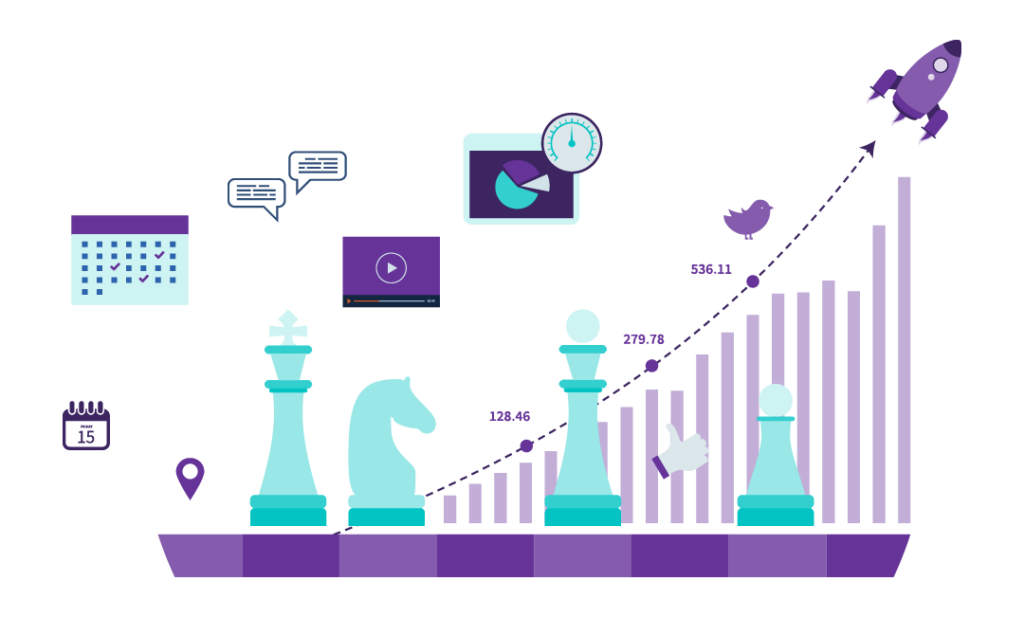There’s no doubt that content marketing is popular with 91% of business-to-business marketers and 86% of business-to-consumer marketers using content marketing. Better yet, content marketing is highly effective. According to DemandMetric, content marketing generates 3X the leads created by traditional marketing strategies yet it costs 62% less. And according to Curata, approximately 78% of buyers relied on white papers to make a purchasing decision within the past year.
But getting it right is difficult and time-consuming, especially if you’re not sure how to get started. That’s why I produced this 6-step guide to content marketing success. If you master these steps, you’ll find content marketing much easier. You have the option to either listen to the audio or continue reading by scrolling down.
Topics covered
Step 1. Create and document a strategy

Perhaps the most important thing you can do to successfully employ content marketing to achieve your business goals is to create and document an integrated content strategy. In fact, 62% of the most successful content marketers have a documented strategy vs. 16% of the least successful. Now they may be correlational statistics and thus it’s impossible to say from that data that a strategy is what made those marketers successful. But in one study, 72% of content marketers who increased their level of success over the previous year credited their strategy as a major contributor. So, chances are, a strategy is an important factor in successful content marketing.
And this stands to reason. A strategy will guide your marketing efforts, ensuring that you stay on track and follow a well-researched, consistent and methodical approach to content marketing. It will tie all your efforts together and help you troubleshoot any issues along the way. Importantly, it will also ensure everyone in your business knows who is responsible for each aspect of your content marketing efforts.
This last point is worth emphasising because it’s often difficult to find spare capacity and the required expertise among existing staff to really make content marketing work. So much so that 62% of companies outsource their content marketing.
So don’t be surprised if you end up needing some outside help to accomplish your content marketing efforts. You might need expert help to produce a great strategy or you might need the talents of a freelance writer or graphic designer to produce exceptional content. Or maybe you’ll need a dedicated project manager who can make sure all the various bits and pieces get done on time. The important thing is to honestly assess your business’s priorities and capabilities so that you can make the best decisions when assigning content marketing responsibilities. And if you need to outsource some of your work, that’s absolutely fine – normal even. Just be sure to set aside appropriate funds to cover that expense.
Despite the importance of having a content marketing strategy, Marketing Profs and the Content Marketing Institute found that 63% of businesses don’t have a documented content strategy. Clearly, if you invest the time, effort, and money required to develop a good strategy, you’ll already have a head start on many other businesses.
Step 2. Consolidate knowledge and research supporting facts

Regardless of whether you’re producing content in-house or outsourcing it, the second step to successful content marketing is getting together the backbones of your content. What are these backbones? They’re your unique industry knowledge plus the supporting research and facts that will back up your views and improve the quality of your content.
You see, every business owner has had a set of unique experiences that has given them expert insight into their industry and how it relates to their niche target market. It doesn’t matter whether you’re a window washer or a multi-million dollar software company. If you’ve been selling a product or service you have developed knowledge and expertise that no one else has because no one else has sold exactly the same product/service to exactly the same customers.
You need to leverage this knowledge and use it to produce unique and valuable content that your competitors cannot produce. This will vastly improve your value proposition to your prospects and customers.
In conjunction with that, you’ll also produce content that’s more valuable to your target audience if you pepper it with well-chosen facts, data, information, and opinions from other relevant experts in your field. When customers and clients see that your content is backed by your expertise and that of other thought leaders and industry experts as well, they’ll be more confident about the views you’re expressing. They’ll learn to trust your content and come to rely on you for quality information and advice. And when they’re ready to make a purchase, you’ll be front of mind.
If your views differ from those of your competitors, being able to point to something that backs up your views will help your prospects and customers trust you and develop a preference for you over those competitors.
No matter your views, the key is to include your unique knowledge and referenced facts, data, and views from others together in every piece of content you produce. So before you start creating your content, gather all this information together in one place so your content is fully informed from the outset. This will involve quite a bit of research and may also require you to interview other experts so give yourself plenty of time to complete this step.
Step 3. Create great content

As content marketing increases in popularity, businesses are more heavily investing in this marketing strategy and a big part of that is investing more in content creation. In fact, 56% of B2B marketers increased spending on content creation in the last 12 months so chances are, at least some of your competitors are investing more in content marketing than they have in the past. If you want to get or stay ahead of your competitors through content marketing, you need to make sure you invest appropriately in creating your own quality content.
If your content marketing efforts are to be successful though, it’s important you focus on investing in consistent content creation. That might mean investing the time to create content yourself, allocating the funds required to purchase quality content or investing in new staff or training for existing staff. Either way, know that your content must be top-notch and you must produce a reasonable amount of it. In fact, data analysis has shown that companies that publish 16+ blog posts per month get almost 3.5 times more traffic than companies that publish zero to four monthly posts.
And I cannot emphasise enough, the importance of consistency. If your prospects and customers suddenly stop getting your content when they expect to, they’ll search for someone else who is providing something close to what they’re after. If they never know when to expect your content, they’re not going to seek it out on a schedule so they’re likely to miss some of your messages. So, when you develop your strategy in step 1, make sure you develop a plan for consistent content creation and stick to it. If you have trouble keeping up, consider hiring someone to help you remain consistent.
Step 4. Distribute and promote content

“Build it and they will come!” Unfortunately, this is pretty much the opposite of what will happen to your content. Once you’ve created quality content, if you just upload it and forget about it only a tiny fraction of your potential audience will ever see it. You have to distribute and promote content if you want it to reach a wide audience. And you have to do so intelligently.
What do I mean by that last point? Let me give you an example:
Jenny sells planners that help busy mums with primary school children get control of their family’s schedule. She writes a blog post and knows she needs to distribute and promote it, so she tweets about the post at 4:00 pm the day the post goes live. Then she gets started on her next blog post.
Now let’s examine two of the issues with that approach.
- Many of the mums that make up Jenny’s target audience pick their kids up from school at 3:30 pm. Therefore, when the tweet goes out, much of her target audience is probably either getting the kids settled at home or taking the kids to after-school activities. Those mums probably won’t check Twitter again until after dinner and by then Jenny’s tweet will be buried below hundreds of other tweets.
- Jenny gets new Twitter followers every day. Even if every one of her existing followers saw the tweet, in a year’s time, hundreds of her newer followers would not have seen it unless they trawled through her tweet history. But the reality is, not all of her existing followers will see the tweet, and tweeting only once means those that miss it will never see it.
Poor Jenny is only sharing her post once and is not even doing so at the right time. Plus, we don’t know whether Twitter is even the best platform for reaching her audience.
These are really common mistakes but ones that are easily fixed.
When you get up to distributing and promoting your content, make sure you share it via the best channels and at the best times, and that you do so multiple times. And don’t forget about your content at the end of the week. Keep sharing it over the coming months.
Something else that’s often overlooked is the value of repurposing content. You can almost certainly distribute content to a wider audience if you share multiple versions of it because even the members of a narrow target audience will prefer to consume content in different formats. As examples:
- Blog posts can be repurposed as emails, eBooks, infographics, and podcasts — and vice versa
- Webinars can be repurposed as videos, slide decks, audio recordings, and mini training courses — and vice versa
- Images can be collated into animations, restyled, and repurposed across a range of media
- Data can be included in blog posts, turned into infographics, and used to create case studies
You might also want to consider organic distribution versus paid promotion. Each enables you to reach different audiences and has pros and cons that mean it’s often ideal to do a mix of the two. Paid promotion is by no means necessary for successful content marketing, but paid boosts of selected content can provide far-reaching benefits to related content and can help you get results faster, particularly if you don’t yet have a large audience of highly engaged followers.
Step 5. Analyse results

A surprisingly large proportion of the content marketing advice out there stops at step 4. But that’s a huge mistake. Once your content is out in the world and you’re distributing and promoting it, you can get much better results if you take the next step and collect and analyse data about how your content is performing.
By using the right metrics to asses how effective your content marketing efforts are, you can determine what content does best with each of your target audiences and make a plan for producing more of that content. You can analyse the effectiveness of individual pieces of content, but there’s no reason to stop there. You can also analyse the effectiveness of classes of content, so you know which types of content work best for your audience.
You can also look at the effectiveness of your distribution and promotion efforts. You should definitely be analysing how effective any paid promotion is, but you’ll also benefit from assessing how effective your organic distribution methods are.
Something as simple as determining the optimal days and times to distribute your content can make a huge difference to the effectiveness of your content marketing.
These are the main things to analyse when you’re assessing how effective your content marketing efforts are, however, there are other things you might want to look at. For instance, you could analyse your workflows for content production and distribution. You might also want to assess how effective your content updates are as knowing which types of content give you the most value when you regularly update them will help you focus your efforts on where they’ll give you the best returns.
By analysing your whole content marketing process, you’ll learn what content works best and how best to produce, distribute, promote, and update it. You’ll also have an opportunity to improve the things that aren’t working as well. In short, you’ll be able to optimise your content marketing.
Step 6. Optimise

Where there’s analysis, there should always be optimisation. Once you’ve determined which content and methods for producing, distributing, promoting, and updating content work best for your business and target audience, you can then pick out anything that isn’t doing well and potentially modify it to boost its effectiveness.
Improving existing content can be a lot cheaper and less resource-intensive than producing new content and when it comes to website content it’s better for your SEO because your site won’t be bogged down by underperforming content that doesn’t rank as well in the SERPs.
To put it another way, if you boost the SERP ranking of individual pages, you’ll boost the overall domain ranking of your website as well. You might hear these referred to as ‘page authority’ and ‘domain authority’.
These terms refer to how well your pages and overall domain (website) are regarded by Google and other search engines. Boosting one boosts the other, but the opposite is true too — harming one harms both. So, getting rid of content that performs poorly is important for good SEO. If you can retain and improve the content rather than deleting it, so much the better.
Similarly, improving any underperforming distribution and promotion methods may mean you can make better use of great content. And optimising your process for producing and updating content might improve your content marketing efficiency.
Get your content marketing off to a great start

Whether you’ve been doing content marketing for a while or are an absolute beginner, these six steps are crucial if you want your content marketing efforts to succeed.
Starting with a solid strategy will give you a framework for your whole content marketing process. Bringing your unique knowledge to bear and gathering solid supporting information will give you a strong foundation for truly valuable content. Allocating the resources you need to produce great content consistently and then continually distribute and promote that content will enable you to conduct content marketing campaigns that get the results you need and continue to build momentum over time. And analysing your content marketing efforts so you can optimise each step of your process will help you get the most out of every action you take and help you be really successful with content marketing.
A final thing to recognise is that, as with any other marketing strategy, content marketing success requires continued effort. You don’t just create one strategy or analyse and optimise your processes once. You instead create a new strategy every year (assuming you’re creating 12-month strategies), you research and create new content (and update existing content) regularly, and perhaps most importantly, you continually assess and optimise your efforts so you can get the most out of every minute and dollar you allocate to your content marketing activities.
So, are you ready to make your next set of content marketing activities the best they can be?
